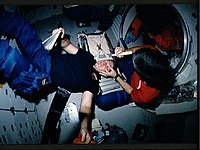
Photo from wikipedia
One of the primary goals of anaesthesia in neurosurgical procedures is prevention of cerebral hypoxia leading to secondary neurological injury. Cerebral oximetry detects periods of cerebral hypoxemia and allows intervention… Click to show full abstract
One of the primary goals of anaesthesia in neurosurgical procedures is prevention of cerebral hypoxia leading to secondary neurological injury. Cerebral oximetry detects periods of cerebral hypoxemia and allows intervention for prevention of secondary brain injury and its sequelae. This can be achieved by the use of Near Infrared Spectroscopy (NIRS). In this regard, we present two cases where erroneous values of NIRS were shown which hindered monitoring of cerebral oxygenation in the intraoperative setting. In a neurosurgical setting, the erroneous values on the operative side could be attributed to altered tissue boundary conditions resulting in a changed optical path, which is normally held as a constant in NIRS measurements. The altered tissue boundary conditions could be due to the presence of air or blood between the myocutaneous flapskull, skull-dura, dura-brain interphases. It could also be that the sensors’ penetrating depth was inadequate to compensate for the increased distance between sensor and brain tissue, thereby resulting in inaccurately higher values (> 80%).
Journal Title: Journal of Clinical Monitoring and Computing
Year Published: 2018
Link to full text (if available)
Share on Social Media: Sign Up to like & get
recommendations!